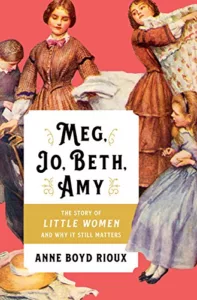Meg, Jo, Beth, Amy: The Story of Little Women and Why It Still Matters
Amy Boyd Rioux
W. W. Norton & Company
Published August 13, 2019
Amazon | Bookshop | Goodreads
About Meg, Jo, Beth, Amy
On its 150th anniversary, discover the story of the beloved classic that has captured the imaginations of generations.
Soon after publication on September 30, 1868, LITTLE WOMEN became an enormous bestseller and one of America’s favorite novels. Its popularity quickly spread throughout the world, and the book has become an international classic. When Anne Boyd Rioux read the novel in her twenties, she had a powerful reaction to the story. Through teaching the book, she has seen the same effect on many others.
In MEG, JO, BETH, AMY, Rioux recounts how Louisa May Alcott came to write LITTLE WOMEN, drawing inspiration for it from her own life. Rioux also examines why this tale of family and community ties, set while the Civil War tore America apart, has resonated through later wars, the Depression, and times of changing opportunities for women.
Alcott’s novel has moved generations of women, many of them writers: Simone de Beauvoir, J. K. Rowling, bell hooks, Cynthia Ozick, Jane Smiley, Margo Jefferson, and Ursula K. Le Guin were inspired by LITTLE WOMEN, particularly its portrait of the iconoclastic young writer, Jo. Many have felt, as Anna Quindlen has declared, “Little Women changed my life.”
Today, Rioux sees the novel’s beating heart in Alcott’s portrayal of family resilience and her honest look at the struggles of girls growing into women. In gauging its current status, Rioux shows why LITTLE WOMEN remains a book with such power that people carry its characters and spirit throughout their lives.
Why I Read Meg, Jo, Beth, Amy
Reading BELITTLED WOMEN by Amanda Sellet stirred up my curiosity about LITTLE WOMEN, which it pays homage to and perhaps very loosely retells. I hadn’t read LITTLE WOMEN and didn’t really know much about it, other than the 1994 movie, which I’ve watched countless times and still love.
A quick internet search about some of the assertions about the story and author mentioned in BELITTLED WOMEN led me to this book. I read LITTLE WOMEN earlier this year so that I’d have more familiarity with the commentary here and could compare it to my own experience reading the book. But I also wanted to read it because I’m seeing more and more retellings of the book.
Anyway. So I read LITTLE WOMEN, and then read this book, giving some history and commentary on it.
My Review
Where do I start? Ha. The book begins with a brief history of Louisa May Alcott’s life, highlighting parts of her childhood and family life that she pulled from in her imagining of her most popular novel. It also discusses her own thoughts about the book and its popularity. For example, she didn’t want to marry Jo off to someone but felt pressured by her fans. She was also known to rush out the back door if fans came to visit her.
The book also talks about how different generations have received LITTLE WOMEN and the changing commentary about the story across the decades. I found that really interesting. There’s a chapter that focuses on adaptations of LITTLE WOMEN to the stage or screen. I’ve only seen the 1994 and 2019 movies, so I made a list of other versions that I’d like to check out. I pitched a LITTLE WOMEN movie binge to my mom and daughter for the week of Thanksgiving, so we’ll see how that project turns out!
There is also a chapter in which the author lists writers who name LITTLE WOMEN as an influence on their work and/or count it among their favorite books. She also talks about who is reading the book still today, and how and when literature began to segregate itself into books for boys versus books for girls.
Conclusion
For the most part, I found this book to be deeply fascinating. I think I zoned out a teeny bit in the section listing authors who were inspired by the story. It was a little repetitive there. But I loved the chapter about the author’s life and the exploration of how different generations have related to this book. I also loved the focus on developing conversations about feminism and different takes on whether the book is progressive or conservative and why.
I’m really glad I read this one, and especially glad it was the catalyst for reading the original work, which I also really enjoyed. If you loved LITTLE WOMEN or even if you’ve never read it and just wonder what the fuss is about, be sure to grab a copy of this one.
Content Notes
Recommended for Ages 14 up.
Representation
The book mainly focuses on the life of Louisa May Alcott and her family.
Profanity/Crude Language Content
Mild profanity used very infrequently.
Romance/Sexual Content
References love and relationships from the book LITTLE WOMEN as portrayed in the book and on screen.
Spiritual Content
Brief discussion of Louisa May Alcott’s father’s restrictive religious beliefs and how they impacted her as a child. Conservatives of the day were upset with the lack of Christianity in the scenes of LITTLE WOMEN. For example, the book opens with the family celebrating Christmas but with no mention of going to church. When a character dies, there is no mention of her ascending to heaven. A stronger Christian theme was more common in popular novels of the day.
Violent Content
Brief mentions of war as a historical fact.
Drug Content
Like the March family, Louisa May Alcott and her family were against any consumption of alcohol.
Note: This post contains affiliate links, which do not cost you anything to use, but which help support this blog.

